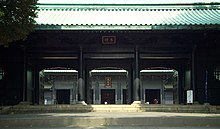Hayashi Hōkō: Difference between revisions
Citation bot (talk | contribs) Misc citation tidying. | Use this bot. Report bugs. | Suggested by AManWithNoPlan | #UCB_CommandLine |
m →External links: Updated default sort |
||
| Line 65: | Line 65: | ||
{{DEFAULTSORT: |
{{DEFAULTSORT:Hayashi, Hōkō}} |
||
[[Category:Japanese writers of the Edo period]] |
[[Category:Japanese writers of the Edo period]] |
||
[[Category:Advisors to Tokugawa shoguns]] |
[[Category:Advisors to Tokugawa shoguns]] |
||
Revision as of 00:29, 25 October 2023
Hayashi Hōkō | |
|---|---|
 Hayashi Hōkō, 1st rector of Yushima Seidō | |
| Born | 1644 Edo |
| Died | 1732 Edo |
| Occupation | Neo-Confucian scholar, academic, administrator, writer |
| Subject | Japanese history, literature |
| Children | Hayashi Ryūkō, son |
| Relatives | Hayashi Gahō, father Hayashi Razan, grandfather |
Hayashi Hōkō (林 鳳岡, January 11, 1644 – July 22, 1732), also known as Hayashi Nobutatsu, was a Japanese Neo-Confucian scholar, teacher and administrator in the system of higher education maintained by the Tokugawa bakufu during the Edo period. He was a member of the Hayashi clan of Confucian scholars.
Hōkō was the tutor of Tokugawa Tsuneyoshi.[1]
Following in the footsteps of his father, Hayashi Gahō, and his grandfather, Hayashi Razan, Hōkō would be the arbiter of official neo-Confucian doctrine of the Tokugawa shogunate. As a result of his urging, the shōgun invested Confucian scholars as samurai.[1]
Academician
Hōkō was the third Hayashi clan Daigaku-no-kami of the Edo period. After 1691, Hōkō is known as the first official rector of the Shōhei-kō (afterwards known as the Yushima Seidō) which was built on land provided by the shōgun.[1] This institution stood at the apex of the country-wide educational and training system which was created and maintained by the Tokugawa shogunate. Gahō's hereditary title was Daigaku-no-kami, which, in the context of the Tokugawa shogunate hierarchy, effectively translates as "head of the state university".[2]
The scholars of the Hayashi school were taught to apply what they had learned from a Confucian curriculum. Typically, they applied the Confucian texts conservatively, relying on Soong Confucian anlayis and metaphysical teachings.[3]
The neo-Confucianist scholar Arai Hakuseki generally expressed scant regard for opinions expressed by Hayashi Hōkō.[3]
Selected works
- Kai hentai (Chinese Metamorphosis), reports of Chinese junks arriving in Nagasaki, 1640–1740.[4]
See also
Notes
- ^ a b c Nussbaum, Louis Frédéric et al. (2005). Japan Encyclopedia, p. 300.
- ^ De Bary, William et al. (2005). Sources of Japanese Tradition, Vol. 2, p. 443.
- ^ a b Arakai, James et al. (2008). Early Modern Japanese Literature: an Anthology, 1600-1900, p. 378 n12.
- ^ Tarling, Nicholas. (1998). The Cambridge History of Southeast Asia, Vol. 1, p. 161.
References

- Arakai, James T. and Haruo Shirane. (2008). Early Modern Japanese Literature: an Anthology, 1600–1900 (abridged). New York: Columbia University Press. ISBN 978-0-231-10990-1/ISBN 978-0-231-10991-8/ISBN 978-0-231-14414-8/ISBN 978-0-231-144155; OCLC 255022419
- De Bary, William Theodore, Carol Gluck, Arthur E. Tiedemann. (2005). Sources of Japanese Tradition, Vol. 2. New York: Columbia University Press. ISBN 9780231129848; OCLC 255020415
- Nussbaum, Louis Frédéric and Käthe Roth. (2005). Japan Encyclopedia. Cambridge: Harvard University Press. ISBN 978-0-674-01753-5; OCLC 48943301
- Tarling, Nicholas. (1998). The Cambridge History of Southeast Asia. Vol. 1. Cambridge: Cambridge University Press. ISBN 978-0-521-77864-0; ISBN 978-0-521-66369-4; ISBN 978-0-521-66370-0; ISBN 978-0-521-66371-7; ISBN 9780521663724; OCLC 43674066
